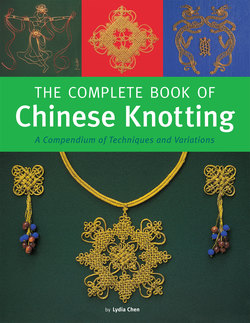Читать книгу The Complete Book of Chinese Knotting - Lydia Chen - Страница 5
ОглавлениеContents
Chinese Knots in Ancient Times
Special Characteristics of Chinese Knots
Chinese Knotting Techniques
FOUR MAIN METHODS OF TYING BASIC KNOTS
NINE WAYS OF MODIFYING BASIC KNOTS
EXTENSIONS AND VARIATIONS OF BASIC KNOTS
Cloverleaf Knot
Pan Chang Knot
Round Brocade knot
Constellation Knot
Good Luck Knot
Buddha Knot
Double Connection Knot
Plafond Knot
Double Coin Knot
Button Knot
Creative Chinese Knotting Designs
CONCEIVING A DESIGN
Real and Imaginary Creatures
Flowers and People
Painting Chinese Knots
Plafond Designs
Jewelry and Ornaments
Born first out of practical necessity in ancient times, Chinese knots were soon employed as decorative motifs on artifacts, both functional and ornamental. Between the Warring States Period, when the prototype of the double coin knot evolved, to the Qing Dynasty, to which the plafond knot has been dated, there is ample archaeological evidence that twelve basic knots were developed by Chinese master craftsmen over the centuries before the modern era.
WARRING STATES PERIOD (475–221 BCE)
Prototype vertical double coin knots on a pedestal box from Zhao Qing’s tomb, Taiyuan, Shanxi Province.
WESTERN HAN PERIOD (206 BCE–CE 8)
Double coin knot
Horizontal double coin knot on a rubbing taken off a stone carving, Western Han Period, from Feng Lu Jiu’s tomb, Tang He, Henan Province.
HAN DYNASTY (206 BCE–CE 220)
Flat knot
Button knot
Flat knot on the top of a jade pendant. Photo courtesy Palace Museum, Taipei.
Button knot on a rubbing taken off a stone carving from an ancient tomb in Shandong Province.
NORTHERN ZHOU PERIOD (CE 557–588)
Good luck knot on a statue of Kuan Yin, the Goddess of Mercy, from cave 55, Maiji Caves, Tianshui, Gansu Province.
Prototype of the good luck knot.
